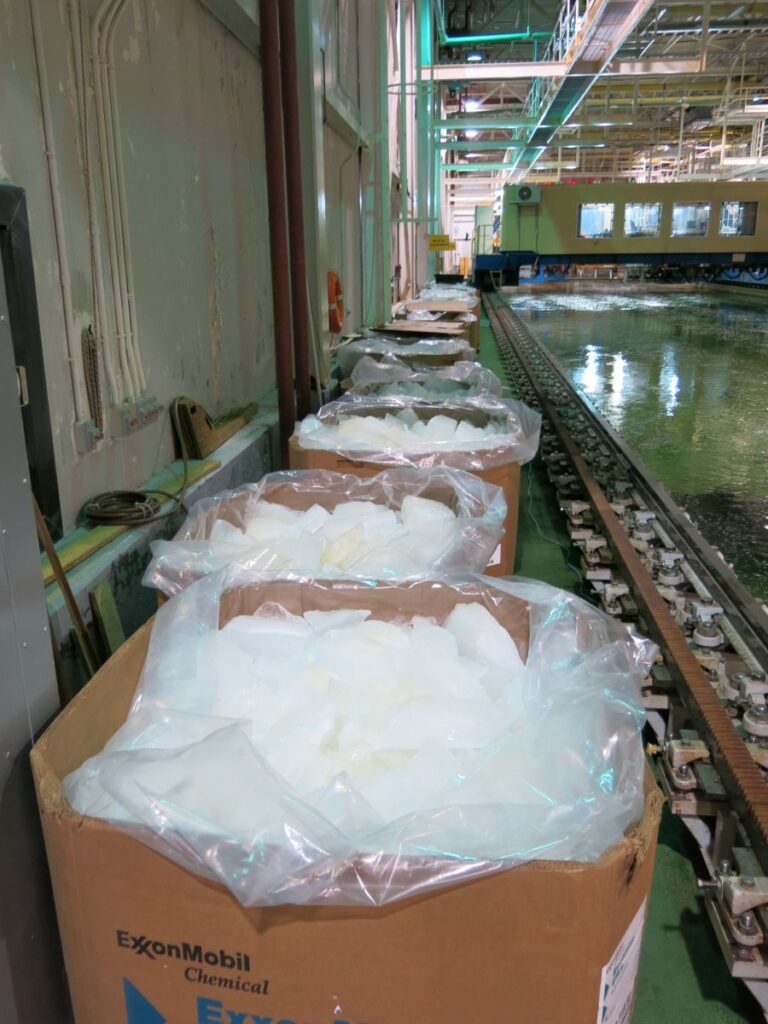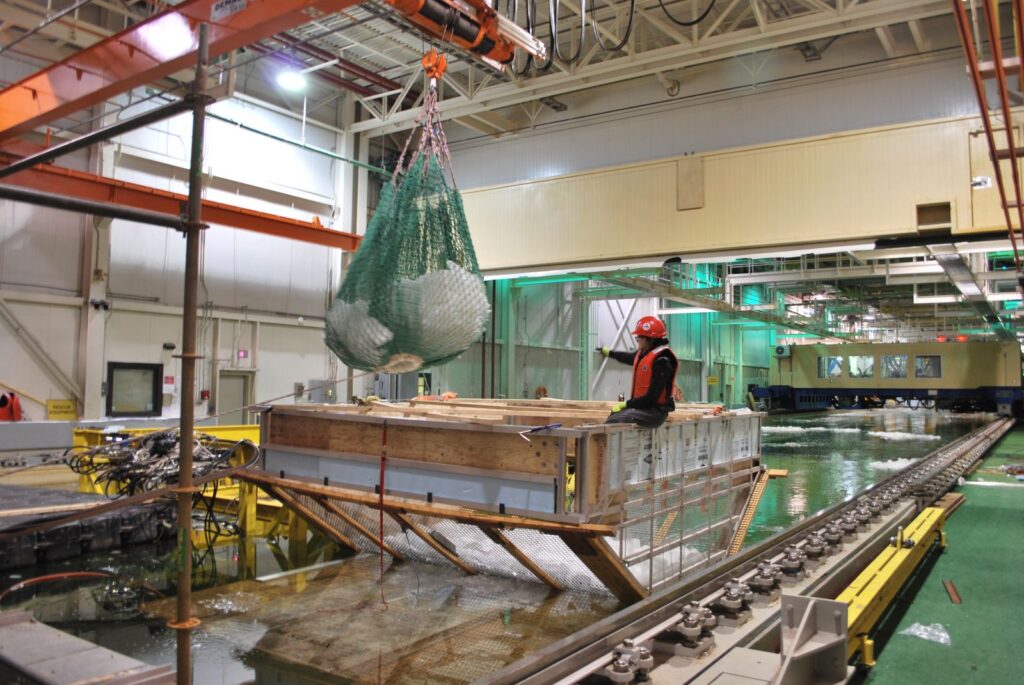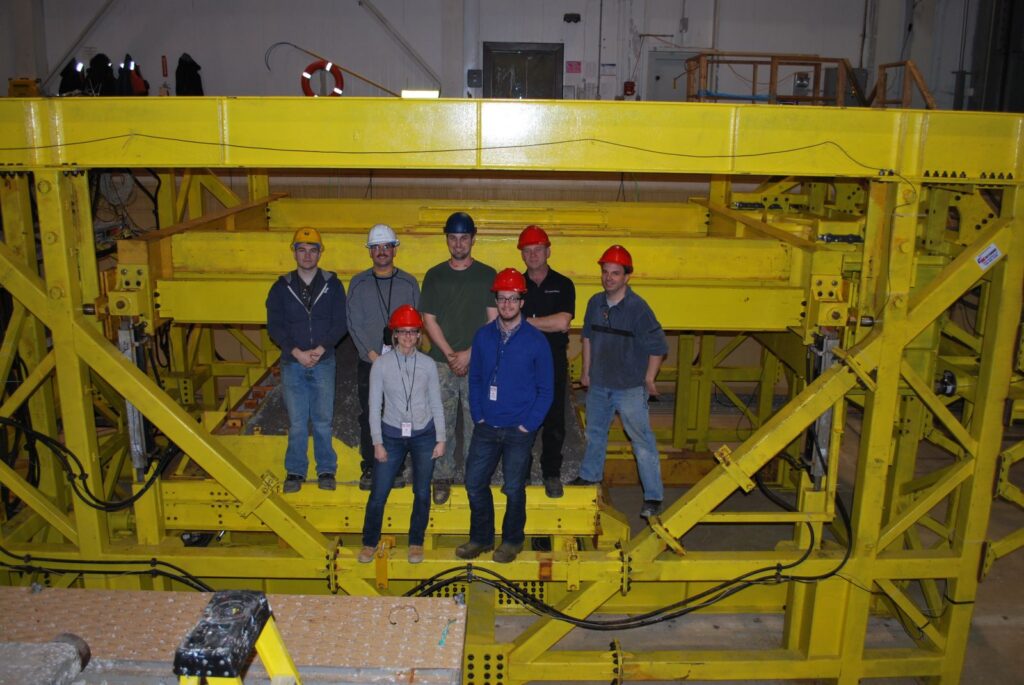Development of Ice Ridge Keel Strength
 LARGE-SCALE EXPERIMENT
LARGE-SCALE EXPERIMENT
The Development of Ice Ridge Keel Strengths (DIRKS) project was a four-year collaborative venture between C‑CORE’s Centre for Arctic Resource Development (CARD) and the National Research Council’s – Ocean, Coastal & River Engineering (NRC-OCRE). Lead by project manager Dr. Eleanor Bailey, the DIRKS project investigated the failure mechanisms associated with gouging ice ridge keels and the conditions under which these keels will continue to gouge without breaking up. This is important for the design of subsea structures in shallow waters where ice keels have been observed to scour the sea floor, posing a threat to pipelines and subsea infrastructure.

FIGURE 1 – ICE RUBBLE LINED UP ALONG THE NRC-OCRE ICE TANK
The main focus of the project was a series of near full-scale keel-gouge tests to investigate the strength characteristics of a first-year ice keel and its eventual failure as it is pushed into an artificial seabed. The project built on a similar series of tests done as part of the Pipeline Ice Risk Assessment and Mitigation (PIRAM) Joint Industry Project, which was led by C-CORE and supported by the Atlantic Canada Opportunities Agency (ACOA) and several oil and gas companies. The key lessons learned from PIRAM were that the initial properties of the ice (particularly the degree of consolidation and bonding) and the confining pressure as the keel begins to dig into the seabed are important factors limiting the gouge depth. The DIRKS project built upon the knowledge gained through PIRAM and was designed to help understand the effects that temperature, confining pressure, consolidation time, and drift speed have on the strength and failure characteristics of a first-year ice keel.

FIGURE 2 – ICE KEEL BUILDING
The testing component of the project was successfully completed in the winter of 2013 (February – April), during which a total of ten keel tests were conducted. The ice keels were constructed using freshwater ice blocks produced in a cold storage facility prior to the start of the test program (see Fig. 1). Ice keels were constructed within a keel former that produced idealized keel geometries: 1.7 m depth, 4 m length and 3.5 m width (Fig. 2). Once constructed, the keels were lowered into the water and left overnight to consolidate while air temperatures were held at -20°C. The keel samples were tested in a custom-built self-reacting frame that was designed and used previously in the PIRAM program (Fig. 3). The frame applied a vertical surcharge load to the top of the keel, whilst a soil tray was displaced horizontally causing the bottom of the ice keel to interact with an artificial seabed.
The DIRKS team (Fig. 3) then analyzed the test results. Findings from DIRKS were intended to ultimately assist oil and gas companies in establishing the physical limits of an ice keel gouge and influence the design criteria for subsea pipelines and infrastructure in areas prone to ice gouging, such as the Beaufort, Barent’s, and Caspian seas.

FIGURE 3 – THE DIRKS TEAM STANDING IN THE TEST FRAME
Back Row, L-R: Kevin King, Andrew Macneil, Mike Melnychuk (C&W Offshore), Randy Cahill (C&W Offshore), Gerry Piercey; Front Row, L-R: Eleanor Bailey, Jon Bruce
Note: DIRKS is also profiled in Memorial University’s 2013 Research Report, “Into the Deep”, which may be found here.